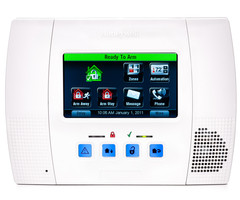Honeywell L5100: Setting up a Babysitter Code
Related Products

Related Categories
Description
This video is about Setting up a Babysitter Code for a Honeywell L5100
Transcript
Hi DYIers, Sterling from Alarm Grid here. Today we're going to show you how to set up and use a babysitter code.
This is a special user code for your LYNX Touch L5100 system, although many other Honeywell systems allow and have a babysitter code assigned. Basically, it's a regular sub-user code, but it acts a little bit different than any other sub-user. We have another video showing you how to set up a user code, but basically if you assign a sub-user code, it's so that you do not have to give out your master code to other people that you want to grant access to arm and disarm your system. A sub-user is allowed to arm, and they are allowed to disarm.
A babysitter code, on the other hand, is also allowed to arm and disarm, but on the disarm, they're only allowed to disarm if the babysitter code was used to arm. Therefore, let's say you and your wife are going out for dinner, the babysitter comes over, you guys are all in the house, you leave, and the system is disarmed. That babysitter would be able to take the kid, let's say they're going out somewhere. They would be able to leave and secure the system using their code. When they come back in, because their code was used to arm, they would then be able to disarm.
However, the next day, once you guys have left to go to work and no one's home, that same babysitter would not be able to come in and disarm the system, since you or your wife had used your code to arm the system. So it's a nice security feature. It allows the babysitter to keep your house secured while they're babysitting, but it does not give them access to come in during unauthorized times. That's a basic description of how the babysitter code works, and now we're going to show you how to assign your system with a babysitter code. We do it through our Master Programming screen, so from the Home Screen we're hitting More, Tools, then we're entering our master code, not our installer code. By default, it's 1-2-3-4.
We are in our Master Code Programming section. We hit users. You can see we have our master code, we have a slot for babysitter, we have a slot for duress, and then we have our sub-user codes. What we're going to do to set the babysitter is toggle it, click edit. You've got the name for babysitter, and it is assigned to user code slot 15. Then we simply toggle into the user code screen, and we can set up a babysitter code. We're going to use 1-4-7-0.
Now, we're going to click done, very important. It's also very important to click save; if you were to simply back out on this screen, it would not take your entry and the babysitter code would not be set up, so we hit save. Back out to the Home Screen, and now we're going to demonstrate how that code can be used. So; babysitter code. Arm/Away. The system arms. Disarm, babysitter code, system disarms. So that shows you the babysitter code can be used to arm and disarm a system, when the system is disarmed.
However, if we use our master code to arm, now when the system is armed and we try to use the babysitter, the system does not disarm. That shows you the security feature that the babysitter code will not be used if the babysitter code was not first used to arm. The only way to disarm at this point is to use a master code or a valid sub-user code. So that explains the babysitter code. If you have any questions on using or setting up your babysitter code, please let us know in the comments section below, and make sure to subscribe to our channel.
- Uploaded
- Duration:
